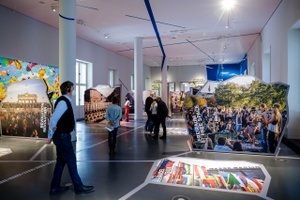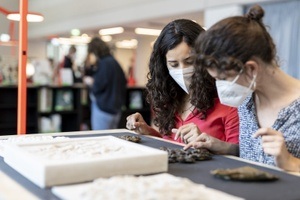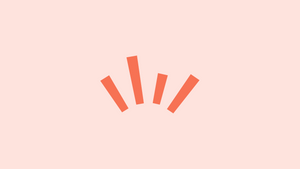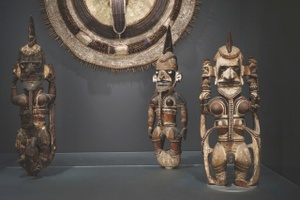Die Farben des Wassers: Braun - Auf dem Trockenen
In the organizer's words:
On the opening weekend of the "On Water" exhibition from 10 to 12 October 2025, everything revolves around the "Colors of Water". Even though water often appears blue, it occurs in nature in very different shades - such as gray, black or red. Many of these colors have meanings, some of them serve as technical and scientific designations.
Taking up the multicolored nature of the wet element, the colorful opening weekend will focus on three of these colors and their associations: on Friday on rivers (green water), on Saturday on water in the city (violet water) and on Sunday on dryness (brown water).
Brown water
Where there is no water, blue, green and silver disappear from the landscape. What remains are shades of brown and cracked ground. However, drought also challenges the spirit of invention: How can we live, design and farm with less water? What proven and new ways are there to store, share and use water sustainably?
This day will focus on techniques and historical experiences in dealing with drought, on the knowledge we can gain from particularly water-scarce regions of the world and on strategies - from traditional water reservoirs to modern sponge cities - that help to overcome the shortage.
Program
10:30-12:30: The future of water - workshop with futurologist Sascha Dannenberg
What is climate change doing to our waters? How will our rivers react if Lusatia dries up? And will we be able to swim everywhere in the city in the future? In an interactive workshop with futurologist Sascha Dannenberg from Freie Universität Berlin, participants will develop various future scenarios for water in Berlin.
11:30-12:30: On Water - family tour
What does it sound like when a tree drinks? How do people around the world deal with increasing drought? What does a puddle researcher do? And how do you study water on Mars?
The "On Water" exhibition in the Humboldt Labor shows research projects by Berlin scientists on the subject of water. In a 60-minute tour that ranges from the sea to an artificial iceberg to the stars, children and families learn about the diversity of scientific research on the wet element and the water-related challenges in times of climate crisis.
14:00-15:00: Meet the Scientist - short presentations on drought research I
14:00-14:30: Indrawan Prabaharyaka: Thirst in the mangrove forest - How design can mitigate water conflicts between species
On the mangrove coast of Muara Gembong near the Indonesian megacity of Jakarta, humans and monkeys live in competition for water. Rising temperatures, deforestation and hyper-salinization are drying up freshwater sources. Unlike human inhabitants, their non-human neighbors cannot simply buy bottled water. During heatwaves, some monkeys therefore die of dehydration, while others seek out water sources near fishing boats and homes, exacerbating the conflict between the species.
From 2022 to 2025, Indrawan Prabaharyaka worked with Labtek Apung - a multidisciplinary collective of experts in environmental engineering, chemistry, architecture, art and anthropology - to find solutions to the conflicts. They developed a prototype water collector that can desalinate seawater in summer and collect rainwater in the monsoon season. While the human designers see it as a water collector, the non-human users seem to regard it as a toy. So how might design be approached differently in terms of interspecies conflict?
(in English)
14:30-15:00: Salam Ebeid: What comes out of the desert sea: fish and other things!
The Red Sea in Egypt is more than just a tourist destination. It is home to many tribal communities who live in the mountains and by the sea. The Al Ababda struggle against many environmental pressures and "tourism development" that affect their traditional way of life and livelihoods. This project primarily explores different bodies of water and traditional fishing methods, but Salam found that women do not only fish for fish, but also for other things. Objects and things that come from the sea are used in everyday life. A kind of salvage economy to mitigate the harshness of the ecology surrounding life in the desert, but also by the sea. Therefore, the sea is not only a source of fish, but also of other things. The sea is a source of wealth and livelihood. It gives. It expels. It has its own power.
(in English)
15:00-16:00: Curator's guided tour "On Water"
with Daniel Tyradellis
Daniel Tyradellis, Humboldt Forum Endowed Chair for the Theory and Practice of Interdisciplinary Curating (funded by the Federal Government Commissioner for Culture and the Media) and Senior Advisor for Curation, will give a guided tour of the exhibition "On Water".
The tour begins in front of the Humboldt Laboratory on the 1st floor of the Humboldt Forum. A guided tour ticket is not required.
Book your free ticket here.
16:00-17:00: Meet the Scientist - Short presentations on drought research II
16:00-16:30: Alexander Schunka: A scarce commodity - water scarcity and water shortage in pre-modern Central Europe
How did people in Central Europe in the early modern period deal with water shortages? How did they react to recurring periods of drought, but also to everyday water shortages? In his lecture, historian Alexander Schunka will focus on the scarcity of resources in the period between 1500 and 1800 as well as contemporary forms of water management and the expansion of water infrastructure in inland territories. He will explain his thesis that water as a scarce resource was often controversial and at the same time required special forms of cooperation in order to ensure a minimum level of social cohesion.
16:30-17:00: Dimitra Almpani-Lekka: Cheimarros - Architectural approaches to urban drought and biodiversity loss
What role can architecture play in coping with increasing urban drought, water management problems and the loss of urban biodiversity? Architect and biodesigner Dimitra Almpani-Lekka explores how water can be integrated into the built environment and how solutions can be found for extreme weather phenomena that are occurring more frequently in the context of the climate crisis. She shows how we can learn from rural and traditional architecture as well as biological organisms and how sharing water in public spaces based on commons networks can contribute to a more resilient city. In her lecture, she will present the installation "Cheimarros", which was created as part of the research project "Water-Driven Membranes" and specially produced for "On Water". This takes up circular processes between water and different species as well as plant and microbial properties for design principles and at the same time invites the audience to reflect on their own embodied knowledge of water.
(in English)
17:00-18:00: Sap Score - sound art and the attempt to put oneself in the shoes of trees
Artist talk with Andreas Greiner and Roland Bolz
With their work Sap Score presented in "On Water", the artist Andreas Greiner and the philosopher and sound engineer Roland Bolz explore the acoustic inner life of trees. The sound artwork developed for the exhibition makes sounds audible that normally remain hidden: from the transportation of water through the xylem to the diverse sounds that accumulate inside and around the trees.
The discussion will focus on artistic strategies that enable a different perception of non-human living beings. What role can sound art play in making it possible to experience nature in a new way and to rethink our relationships with it? How can the urgency of the climate crisis be conveyed aesthetically without lapsing into anthropomorphization? The audience is invited to listen to and perceive the trees as co-beings of our living world.
Moderation: Anna-Lisa Dieter
- free of charge
- from 14 years
- Language: German
- Humboldt Laboratory, 1st floor
- Belongs to: On Water
This content has been machine translated.














Gemeinsam Events erleben
Events werden noch schöner wenn wir sie teilen! Deshalb kannst du dich jetzt mit Friends und anderen Usern vernetzen um Events gemeinsam zu besuchen. Loslegen